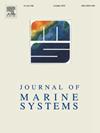Global surface ocean calcite saturation (Ωcal) estimation using satellite and in-situ observations
IF 2.5
3区 地球科学
Q2 GEOSCIENCES, MULTIDISCIPLINARY
引用次数: 0
Abstract
Calcite saturation (Ωcal) in global surface ocean waters is a crucial parameter for assessing marine ecosystem health. This study presents a multiparametric linear regression (MLR) model integrating satellite and in-situ observations to estimate global surface ocean Ωcal. The model was developed using in-situ measurements of sea surface temperature (SST), sea surface salinity (SSS), total alkalinity (TA), dissolved inorganic carbon (DIC) and Ωcal obtained from the National Center for Environmental Information (NCEI), combined with satellite derived chlorophyll concentrations (Chla). Model validation demonstrated strong agreement with in-situ data, indicating high accuracy of estimation. Satellite derived Ωcal estimates also showed robust correlations with in-situ measurements, confirming the MLR model reliability. Sensitivity analysis highlighted the model resilience to variations in input parameters. This study reveals significant spatiotemporal variability in Ωcal, driven by physical, chemical, and biological processes, including seasonal patterns and climate phenomena like the El Nino Southern Oscillation (ENSO) and North Atlantic Oscillation (NAO). Analysis of interannual trends and the rate of change in Ωcal emphasize the impacts of ocean acidification, revealing a declining trend that poses challenges to marine ecosystems. The proposed approach offers a valuable tool for monitoring global ocean carbonate chemistry, providing insights into the long term impacts of environmental changes on marine health and enabling informed decision making for ecosystem management.
利用卫星和原位观测估算全球海洋表面方解石饱和度(Ωcal)
全球表层海水方解石饱和度(Ωcal)是评估海洋生态系统健康的重要参数。本文提出了一种综合卫星和现场观测的多参数线性回归(MLR)模型,用于估算全球表面海洋Ωcal。该模型是利用美国国家环境信息中心(NCEI)提供的海表温度(SST)、海表盐度(SSS)、总碱度(TA)、溶解无机碳(DIC)和Ωcal的原位测量数据,结合卫星衍生叶绿素浓度(Chla)建立的。模型验证与现场数据吻合较好,具有较高的估计精度。卫星推导的Ωcal估计值也显示出与原位测量值的强相关性,证实了MLR模型的可靠性。敏感性分析强调了模型对输入参数变化的弹性。该研究揭示了Ωcal的显著时空变异,受物理、化学和生物过程驱动,包括季节模式和气候现象,如厄尔尼诺-南方涛动(ENSO)和北大西洋涛动(NAO)。对Ωcal年际趋势和变化率的分析强调了海洋酸化的影响,揭示了对海洋生态系统构成挑战的下降趋势。提出的方法为监测全球海洋碳酸盐化学提供了一个有价值的工具,提供了对环境变化对海洋健康的长期影响的见解,并为生态系统管理提供了明智的决策。
本文章由计算机程序翻译,如有差异,请以英文原文为准。
求助全文
约1分钟内获得全文
求助全文
来源期刊

Journal of Marine Systems
地学-地球科学综合
CiteScore
6.20
自引率
3.60%
发文量
81
审稿时长
6 months
期刊介绍:
The Journal of Marine Systems provides a medium for interdisciplinary exchange between physical, chemical and biological oceanographers and marine geologists. The journal welcomes original research papers and review articles. Preference will be given to interdisciplinary approaches to marine systems.
 求助内容:
求助内容: 应助结果提醒方式:
应助结果提醒方式:


